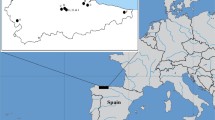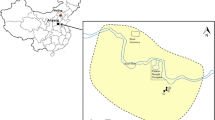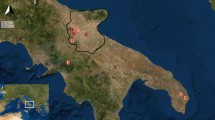Abstract
This study uses stable isotope analyses (δ13C and δ15N) of human bone collagen to reconstruct the diet of three Romano-British (first to early fifth century AD) populations from Gloucestershire in South West England. Gloucestershire was an important part of Roman Britain with two major administrative centres at Gloucester (Glevum) and Cirencester (Corinium) and numerous smaller settlements and farmsteads. To investigate potential dietary differences between the rural and urban populations of Roman Gloucestershire, we compared human bone collagen stable isotope values from 32 individuals from urban Gloucester with those of 46 individuals from two rural cemeteries at Horcott Quarry and Cotswold Community, respectively. Seven individuals from urban Gloucester were buried in a mass grave; all others were buried in single inhumations. Results show small but significant differences in stable isotope ratios between the urban and rural populations which indicate that the urban population might have consumed slightly more marine and/or freshwater resources than the people living in the rural communities. We interpret this difference as a direct reflection of Rome’s influence on Gloucester’s population and the town’s economic status. Subtle differences in stable isotope ratios were also observed at the site level, as burial practice does correlate with diet in some cases. Overall, the results from this study demonstrate that diet, as reconstructed through stable isotope analysis, is a very sensitive, if settlement-specific, indicator of social differentiation and culture change.





Similar content being viewed by others
References
Albarella U, Johnstone C, Vickers K (2008) The development of animal husbandry from the late Iron Age to the end of the Roman period: a case study from South-East Britain. J Archeol Sci 35:1828–1848
Alcock JP (2002) Food in Roman Britain. Tempus Publishing Inc., Stoud
Allen TG (1990) An Iron Age and Romano-British enclosed settlement at Watkins Farm, Northmoor, Oxon. Thames Valley Landscape Volume 1. Oxford Archaeology, Oxford
Ambrose SH (1990) Preparation and characterization of bone and tooth collagen for isotopic analysis. J Archaeol Sci 17:431–451
Ambrose SH, Buikstra J, Krueger HW (2003) Status and gender differences in diet at Mound 72, Cahokia, revealed by isotopic analysis of bone. J Anthropol Archaeol 22:217–226
Bekker-Nielsen T (2002) Fish in the ancient economy. In: Skydsgaard JE, Ascani K (eds) Ancient history matters: studied presented to Jens Erik Skydsgaard on his seventieth birthday. Rome, Accademia di Danimarca, pp 29–37
Bogaard A, Heaton THE, Poulton P, Merbach I (2007) The impact of manuring on nitrogen isotope ratios in cereals: archaeological implications for reconstruction of diet and crop management practices. J Archaeol Sci 34:335–343
Booth P (2007) Pottery. In: Miles D, Palmer S, Smith A, Jones GP (eds) Iron Age and Roman Settlement in the Upper Thames Valley: excavations at Claydon Pike and other sites within the Cotswold Water Park. Oxbow, Oxford, pp 186–189
Booth P, Dodd A, Robinson M, Smith A (2007) The Thames through time: the archaeology of the gravel terraces of the Upper and Middle Thames—the Early Historical Period AD1–1000. Oxford Archaeology, Oxford
Brady K (2009) Excavations at Horcott Quarry. Current Archaeol 224:34–40
Chenery C, Müldner G, Evans J, Eckardt H, Lewis M (2010) Strontium and stable isotope evidence for diet and mobility in Roman Gloucester, UK. J Arch Sci 37:150–163
Chisholm BS, Nelson DE, Schwarcz HP (1982) Stable-carbon isotope ratios as a measure of marine versus terrestrial protein in ancient diets. Science 216:1131–1132
Clarke S (1996) Acculturation and continuity: re-assessing the significance of Romanization in the hinterlands of Gloucester and Cirencester. In: Webster J, Cooper N (eds) Roman imperialism: post-colonial perspectives. University of Leicester, School of Archaeological Studies, pp 71–84
Cook GT, Bonsall C, Hedges REM, McSweeney K, Boronean V, Pettitt PB (2001) A freshwater diet-derived 14C reservoir effect at the Stone Age sites in the Iron Gates gorge. Radiocarbon 43:453–460
Cool H (2006) Eating and drinking in Roman Britain. Cambridge University Press, Cambridge
Corcoran TH (1963) Roman fish sauces. Class J 58:204–210
Craig OE, Biazzo M, O'Connell TC, Garnsey P, Martinez-Labarga C, Lelli R, Salvadei L, Tartaglia G, Nava A, Reno L, Fiammenghi A, Rickards O, Bondioli L (2009) Stable isotopic evidence for diet at the Imperial Roman coastal site of Velia (1st and 2nd Centuries AD) in Southern Italy. Am J Phys Anth 139:572–583
Cummings C (2008) Food and society in Late Roman Britain: determining dietary patterns using stable isotope analysis. University of Oxford, Dissertation
Cunliffe B (1991) Iron Age communities in Britain: an account of England, Scotland and Wales from the seventh century until the Roman conquest. Routledge, London
DeNiro MJ (1985) Postmortem Preservation and Alteration of in vivo Bone Collagen Isotope Ratios in Relation to Palaeodietary Reconstruction. Nature 317:806–809
Dobney K, Ervynck A (2007) To fish or not to fish? Evidence for the possible avoidance of fish consumption during the Iron Age around the North Sea. In: Haselgrove C, Moore T (eds) The Later Iron Age in Britain and beyond. Oxbow Books, Oxford, pp 403–418
Duncan-Jones RP (1996) The impact of the Antonine Plague, J Rom Archeol 9:108–136
Dürrwächter C, Craig OE, Collins MJ, Burger J, Alt KW (2006) Beyond the grave: variability in Neolithic diets in Southern Germany? J Archeol Sci 33:39–48
Feldman C (2005) Roman taste. Food, Culture and Society: Int J of Multidisc Res 8:7–30
Frere S (1999) Britannia: A History of Roman Britain. Pimlico, London
Fuller BT, Fuller JL, Harris DA, Hedges REM (2006) Detection of breastfeeding and weaning in modern human infants with carbon and nitrogen stable isotope ratios. Biological Anthropology 129:279–293
Gardner JF (1991) Women in Roman law and society. Indiana University Press, Bloomington
Garnsey P (1999) Food and society in classical antiquity. Cambridge University Press, Cambridge
Gerrard J (2007) Rethinking the small pig horizon at York Minster. Oxf J Arch 26:303–307
Grant A (1989) Animals in Roman Britain. In: Todd M (ed) Research on Roman Britain. Society for the Promotion of Roman Studies, London, pp 135–146
Grant A (2000) Diet, economy and ritual: evidence from the faunal remains. In M. Fulford (ed.) Iron Age and Roman Silchester: Excavations on the Site of the Forum-Basilica at Silchester 1977, 1980–86. Society for the Promotion of Roman Studies, London, pp. 423–80
Grant A (2004) Domestic animals and their uses. In: A companion to Roman Britain. Blackwell Publishing, Oxford, 371–92
Hambleton E (1999) Animal husbandry regimes in Iron Age Britain: a comparative study of faunal assemblages from British Iron Age sites. Archaeopress, Oxford
Harbeck M, Grupe G (2009) Experimental chemical degradation compared to natural diagenetic alteration of collagen: implications for collagen quality indicators for stable isotope analysis. Archaeol Anthropol Sci 1:43–57
Harding DW (2004) The Iron Age in Northern Britain: Celts and Romans, natives and invaders. Routledge, New York
Haverfield F (1923) The Romanization of Roman Britain. Clarendon, Oxford
Hedges REM, Reynard LM (2007) Nitrogen isotopes and the trophic level of humans in archaeology. J Archaeol Sci 34:1240–1251
Hobson K, Alisauskas R, Clark R (1993) Stable-nitrogen isotope enrichment in avian tissues due to fasting and nutritional stress: implications for isotopic analyses of diet. Condor 94:388–394
Jay M (2008) Iron Age diet at Glastonbury Lake Village: the isotopic evidence for negligible aquatic resource consumption. Oxf J Archeol 27:201–216
Jay M, Richards M (2007) British Iron Age diet: stable isotopes and other evidence. Proc Prehist Soc 73:169–190
Katzenberg MA (2008) Stable isotope analysis: a tool for studying past diet, demography and life history. In: Katzenberg MA, Saunders SR (eds) Biological anthropology of the human skeleton. Wiley-Liss, New York, pp 305–328
Katzenberg MA, Lovell NC (1999) Stable isotope variation in pathological bone. Int J Osteoarch 9:316–324
Katzenberg MA, Weber A (1999) Stable isotope ecology and palaeodiet in the Lake Baikal Region of Siberia. J Archeol Sci 26:651–659
King A (1999) Diet in the Roman World: a regional inter-site comparison of the mammal bones. J Rom Archeol 12:168–202
Kjellström A, Storå J, Possnert G, Linderholm A (2009) Dietary patterns and social structures in medieval Sigtuna, Sweden, as reflected in stable isotope values in human skeletal remains. J Archaeol Sci 36:2689–2699
Le Huray JD, Schutkowski H (2005) Diet and social status during the La Tčne period in Bohemia: carbon and nitrogen stable isotope analysis of bone collagen from Kutná Hora-Karlov and Radovesice. J Anthropol Archaeol 24:135–147
Locker A (2007) In piscibus diversis: The bone evidence for fish consumption in Roman Britain. Britannia 38:141–180
Lubell D, Jackes M, Schwarcz HP, Knyf M, Meiklejohn C (1994) The Mesolithic–Neolithic transition in Portugal: isotopic and dental evidence of diet. J Archeol Sci 21:201–216
Maltby M (1997) Domestic fowl on Romano-British Sites: inter-site comparisons of abundance. Int J Osteoarch 7:402–414
Mattingly D (2008) Urbanism, epigraphy and identity in the towns of Britain under Roman Rule. In: Schellenberg H M, Hirschmann V E, Krieckhaus A (eds) A Roman miscellany: essays in honour of Anthony R. Birley on his Seventieth Birthday. Oxford: Oxbow Books: 53–71
McWhirr A (1981) Roman Gloucestershire. Alan Sutton, Gloucester
Meadows K (2002) The appetites of households in Early Roman Britain. In: Allison M (ed) The archaeology of household activities. Routledge, London, pp 101–116
Miles D, Palmer S, Smith A, Jones G (2007) Iron Age and Roman Settlement in the Upper Thames Valley: excavations at Claydon Pike and other sites within the Cotswold Water Park. Oxford Archaeology, Oxford
Millett M (1992) The Romanization of Britain. Cambridge University Press, Cambridge
Minagawa M, Wada E (1984) Stepwise enrichment of 15N along food chains: further evidence and the relation between δ15N and animal age. Geochim Cosmochim Acta 48:1135–1140
Müldner G, Richards M (2007) Stable isotope evidence for 1500 years of human diet at the City of York, UK. Am J Phys Anth 133:682–697
Nehlich O, Boric D, Stefanovic S, Michael Richards MP (2010) Sulphur isotope evidence for freshwater fish consumption: a case study from the Danube Gorges, SE Europe. J Archeol Sci 37:1131–1139
Newsome S, Philips D, Culleton B, Guilderson T, Koch P (2004) Dietary reconstruction of an Early to Middle Holocene human population from the Central California Coast: insights from advanced stable isotope mixing models. J Archeol Sci 31:1101–1115
Piola RF, Moore SK, Suhers IM (2006) Carbon and nitrogen stable isotope analysis of three types of oyster tissue in an impacted estuary. Estuarine Coastal Shelf Sci 66:255–266
Polet C, Katzenberg MA (2003) Reconstruction of the diet in a Mediaeval monastic community from the Coast of Belgium. J Archaeol Sci 30:525–533
Powell K, Nicholson R (2010) Chapter 16: Marine Shell. In: Powell K, Smith A Laws G (eds.) Evolution of a farming community in the Upper Thames Valley. Volume 1: Site narrative and overview. Oxford Archaeology Thames Valley Landscapes Monographs 31. Oxford: Oxford Archaeology
Powell K, Smith A, Laws G (2010) Evolution of a Farming Community in the Upper Thames Valley. Volume 1: Site narrative and overview. Oxford Archaeology Thames Valley Landscapes Monographs 31. Oxford: Oxford Archaeology
Privat KL, O'Connell TC, Richards MP (2002) Stable isotope analysis of human and faunal remains from the Anglo-Saxon Cemetery at Berinsfield, Oxfordshire: dietary and social implications. J Archaeol Sci 29:779–790
Privat KL, O'Connell TC, Hedges REM (2007) The distinction between freshwater-and terrestrial-based diets: methodological concerns and archaeological applications of sulphur stable isotope analysis. J Archaeol Sci 34:1197–1204
Prowse T, Schwarcz H, Saunders S, Macchiarelli R, Bondioli L (2005) Isotopic evidence for age-related variation in diet from Isola Sacra, Rome, Italy. Am J Phys Anth 128:2–13
Redfern R, Hamlin C, Athfield N (2010) Temporal changes in diet: a stable isotope analysis of Late Iron Age and Roman Dorset, Britain. J Archeol Sci 37:1149–1160
Richards MP, Hedges REM (1999) Stable isotope evidence for similarities in the types of marine foods used by Late Mesolithic Humans at sites along the Atlantic Coast of Europe. J Archeol Sci 26:717–722
Richards MP, Hedges REM, Molleson TI, Vogel JC (1998) Stable isotope analysis reveals variations in human diet at the Poundbury Camp cemetery site. J Archeol Sci 25:1247–1252
Richards MP, Fuller B, Molleson T (2006) Stable isotope palaeodietary study of humans and fauna from the multi-period (Iron Age, Viking and Late Medieval) site of Newark Bay, Orkney. J Archeol Sci 33:122–131
Rutgers LV, van Strydonck M, Boudin M, van der Linde C (2009) Stable isotope data from the early Christian catacombs of ancient Rome: new insights into the dietary habits of Rome's early Christians. J Archael Sci 36:1127–1134
Schoeninger MJ, DeNiro MJ (1984) Nitrogen and carbon isotopic composition of bone collagen from marine and terrestrial animals. Geochim Cosmochim Acta 48:625–639
Schoeninger MJ, DeNiro MJ, Tauber H (1983) Stable nitrogen isotope ratios of bone collagen reflect marine and terrestrial components of prehistoric human diet. Science 220:1381–1383
Schutkowski H, Herrmann B, Wiedemann F, Bocherens H, Grupe G (1999) Diet, status and decomposition in Weingarten. Trace elements and isotope analyses on Early Mediaeval skeletal material. J Archaeol Sci 26:675–685
Sealy J, Armstrong RA, Schrire C (1995) Beyond lifetime averages: tracing life histories through isotopic analysis of different calcified tissues from archaeological human skeletons. Antiquity 69:290–300
Serjeantson D, Wales S, Evans J (1994) Fish in later prehistoric Britain. In Heinrich D (ed.), Archaeo-Ichthyological Studies. Papers presented at the 6th meeting of the ICAZ fish remains working group. Sonderdruck Offa, 51. Wacholz Verlag, Neuemünster, pp. 332–9
Simmonds A., Marquez-Grant N, Loe L (2008) Life and death in a Roman city: excavation of a Roman cemetery with a mass grave at 120–122 London Road, Gloucester. Oxford Archaeology Monograph 6. Oxford Archaeology, Oxford
Tafuri MA, Craig OE, Canci A (2009) Stable isotope evidence for the consumption of millet and other plants in Bronze Age Italy. Am J Phys Anth 139:146–153
Thompson AH, Richards MP, Shortland A, Zakrzewski SR (2005) Isotopic palaeodiet studies of ancient Egyptian fauna and humans. J Archaeol Sci 32:451–463
Trueman CN, McGill RAR, Guyard PH (2005) The effect of growth rate on tissue-diet isotopic spacing in rapidly growing animals. An experimental study with Atlantic Salmon (Salmo salar). Rapid Commun Mass Spectrom 19:3239–3247
van der Merwe NJ (1982) Carbon isotopes, photosynthesis, and archaeology. Am Sci 70:596–606
van der Merwe NJ, Williamson RF, Pfeiffer S, Thomas SC, Oakberg Allegretto K (2003) The moatfield ossuary: isotopic dietary analysis of an Iroquoian community, using dental tissue. J Anth Archaeol 22:245–261
van der Veen M, Livarda A, Hill A (2008) New plant foods in Roman Britain: dispersal and social access. Env Archaeol 13:11–36
van Klinken G (1999) Bone collagen quality indicators for palaeodietary and radiocarbon measurements. J Archeol Sci 26:687–695
Walker PL, DeNiro MJ (1986) Stable nitrogen and carbon isotope ratios in bone collagen as indices of prehistoric dietary dependence on marine and terrestrial resources in Southern California. Am J Phys Anth 71:51–61
Webster J (2001) Creolizing the Roman provinces. Am J Archaeo 105:209–225
Willcox G (1977) Exotic plants from Roman waterlogged sites in London. J Archeol Sci 4:269–282
Wilson CA (1973) Food and drink in Britain from the Stone Age to recent times. Constable, London
Acknowledgements
We thank David Rice from Gloucester City Museum, Alison Brookes from Corinium Museum and Ceri Boston, Louise Loe, David Mullin and Alex Smith from Oxford Archaeology for providing the samples. Thanks also go to our colleagues at the RLAHA, particularly to Julie Hamilton and Dr. Peter Ditchfield, for their technical and moral supports. Special thanks to the two anonymous reviewers for their insightful and helpful comments. This project was part of an MSc programme funded by the Tang Oxford Award, China Oxford Scholarship Fund. C.C. would also like to thank her father Stanly Cheung for covering all additional expenses incurred in this programme.
Author information
Authors and Affiliations
Corresponding author
Rights and permissions
About this article
Cite this article
Cheung, C., Schroeder, H. & Hedges, R.E.M. Diet, social differentiation and cultural change in Roman Britain: new isotopic evidence from Gloucestershire. Archaeol Anthropol Sci 4, 61–73 (2012). https://doi.org/10.1007/s12520-011-0083-y
Received:
Accepted:
Published:
Issue Date:
DOI: https://doi.org/10.1007/s12520-011-0083-y




